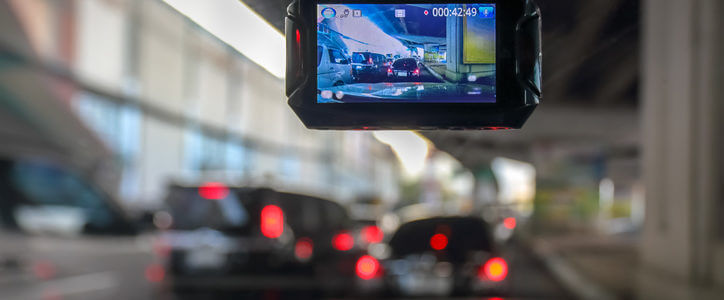Autonomous vehicles are considered the future. From Uber to Apple to Amazon, investment in self-driving cars and trucks continues to ramp up. But there’s a long way to go before these reach critical mass as training artificial intelligence is laborious. When it comes to humans as drivers, it is easy for our brains to identify and comprehend a “traffic cone” and whether that cone is in full working condition, covered in snow, or damaged. This is something that may take a while to train autonomous vehicles.
Two Decades of Technological Innovation
However, a future in AI has given us technology in the present – built to make people and the process of driving safer. The early 2000s gave us a taste; less than two decades ago, GPS was opened up for civilian use and backup sensors were anything but standard. By 2010, dashcams exited the realm of the police force and started to become more accessible for consumers and businesses in fraud-laden areas.
But even a decade ago, there was little connection. Telematics, now a standard part of any fleet, was essentially nonexistent. Sensors did little more than help you know if you were backing up into something. Cameras offered little more than a bit of security in the event someone kicked it into reverse at a stoplight.
A Connected Experience: Telematics and Cameras Offer a Wealth of Benefits
The last few years, however, have given us new levels of connectivity. Today’s cars, trucks, and fleet vehicles provide visibility, maintenance awareness, and a better understanding of behaviors, combining to deliver benefits to end users, fleet managers, and insurers. Linda Stoppacher, Senior Loss Control Consultant at Acadia Insurance notes,
Technologies, such as integrated telematics and cameras, have revolutionized transportation safety in so many ways: they can be used to bring about the best driving behaviors, some have collision avoidance perks, they can be used in claim resolution and fraud avoidance, and often have operational benefits to the end user.
Benefits Multiplied: A Holistic Approach to Risk Mitigation
Each of these technologies delivers value on its own—but together the benefits are multiplied. For example, a telematics solution alone could identify a risky behavior, note the location and time. On its own, a camera could show a road hazard.
But when combined, Stoppacher adds, everyone can benefit. From helping identify positive, defensive, and avoidant actions to pointing out risky behavior and highlighting learning opportunities, end users and managers can get more from the investment.
A technology user can receive an alert of a risky behavior (such as speeding, hard braking, or rapid acceleration) and pair it with the camera footage to interpret a driving situation. It could be something as simple as a car pulling out in front of the insured driver, in which case one would congratulate his or her decision making and rapid response. Or, it could point out close following, inattentive behavior, or a riskier route.
All of these situations can be discussed with the driver and corrective action can be taken. The telematics data can also be used to identify trends and the highest risk drivers so that safety activity can be focused accordingly. Many of the technology providers include coaching materials with their products.
The Continued Push Forward: From Connected Information to Coordinated Improvement
But even the simple connection has been pushed. Just as consumer automobiles have evolved from the nascent days of cruise control into a technologically-empowered driving experience complete with lane monitoring, eye tracking, and improved blind spot tracking, so has the fleet and logistics space. Better yet, this information is becoming more and more actionable. Stoppacher adds,
As the technologies evolve, they are becoming even more helpful. In its infancy, one would receive an alert of a behavior either in real time or in a condensed format. Then, discussions could be held either through dispatch or phone call, or hours after the event which is less effective. Some technologies will provide in cab alerts if it senses lane drifting, close following distances, or even inattention. A sound is heard by the driver, in real time, where it can do the most good.
After all, a live notification does a lot more than a daily debriefing—few are going to respond positively to “we saw that you drifted a bit at 12:07 P.M. at mile mark 163, care to explain what happened?”
Why This Matters: Your Answer to “What If?”
Knowing the impact that real time technology can have on actively improving the safety of your own fleet, can help you gain a lot more from the passive benefit—having the answer to “what if?” Accidents happen, and all too often, a seemingly small incident can turn into something much more convoluted and costly.
This is where telematics and cameras truly shine, according to Stoppacher:
It is not uncommon for a property damage only accident to appear small and relatively inconsequential at first. However, there is a percentage which will develop into larger liability oriented claims at a later date.
Having telematics data which pinpoints position and speeds before, during and after impact as well as camera footage can get to the bottom of what really happened. Without this information, it can become murky through recollections of various parties and time.
In some cases, it can even help prevent a potential fraud situation. For example, consider a scenario where a claimant insists your tractor trailer hit their vehicle at an intersection. Camera footage, however, clearly shows the claimant vehicle moving and driving into your tractor trailer. Even in a seemingly minor incident, preserving telematics data and camera footage is a best practice.
Winning over Nonbelievers
Think of a technology you take for granted right now. Your laptop or home computer? Your… Vehicle? At some time or another, each of these was considered frivolous. In 1985, the New York Times doubted the idea of laptops ever becoming mainstream, calling them bulky and expensive. In 1902 they called the automobile impractical.
Often, telematics holdouts say the same thing—at least initially. Much like the adoption of personal computers and automobiles, once the naysayers get to experience the product, it goes from ‘frivolous fad’ to ‘how did we live without it?’
“Although some customers initially resist the cost and burden of installation, most soon wonder how they operated without it” Stoppacher adds, highlighting a variety of positive experiences from former nonbelievers.
From a waste hauler company calling out a garbage excuse:
One waste hauler I’ve worked with has used the system to solve customer service issues. For example, someone claimed their garbage was not picked up even though her son had it out early that morning. Footage of the neighborhood showed that the son wasn’t as early as the caller had thought.
To a distributor collaborating with drivers in real time to reduce risk:
A beverage distributor located in a mountainous area uses their real time camera footage to make decisions with the driver during periods of bad weather. They can avoid heading into higher elevations in winter weather through joint decision making and a simple postponement call to the customer.
To a driver who invalidated a ticket and maintained their safety record:
Another customer received a ticket for having debris falling out of their truck. They utilize a multi-angle camera system and were able to invalidate the ticket and resulting mark against their safety rating by showing that the debris was already on the road and was merely disturbed by the wind current caused by their truck passing the area.
The technologically enabled fleet is safer, more cost effective, and has much more to gain than to lose.
Mitigating Risk at Every Turn: Acadia Insurance Is There For Your Transportation Business
We understand that many drivers still doubt the use of technology and many managers doubt the costs compared to the benefits. But in an industry whose reputation is made or broken on safety, this technology could be your greatest defense. Much like the use of telematics and cameras can provide the answer to “what if?”, the same goes for your insurance. Luckily, both are there to protect your people and your business.
If you own a transportation company, you confront risk at every turn. You need an insurance carrier that understands your business and the unique exposures you face. Acadia Insurance is a leading regional insurance provider serving trucking companies like yours.
Our broad product portfolio includes a wide range of coverage options and our experienced network of agents understands the challenges present in your industry and location. Get to know more about our coverage options and find an agent using our handy tool.
Acadia Insurance is pleased to share this material with its customers. Please note, however, that nothing in this document should be construed as legal advice or the provision of professional consulting services. This material is for general informational purposes only, and while reasonable care has been utilized in compiling this information, no warranty or representation is made as to accuracy or completeness.
[SD1]We may want to re-work this sentence.




